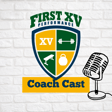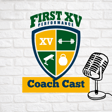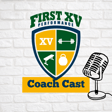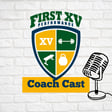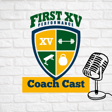Become a Creator today!Start creating today - Share your story with the world!
Start for free
00:00:00
00:00:01

First XV Coach Cast Episode 12- Buy In From Young Athletes
I return after a break and dive into the importance of building trust and buy-in with athletes, especially in team sports. I discuss fostering positive relationships with athletes, ensuring engagement, and creating a culture of trust and development in coaching
Make sure you hit subscribe & share on your favorite podcast app and follow me on Instagram- JDykeFXV
Transcript
Introduction and Return of the Coach
00:00:01
Jarrod Dyke
Hello again, once once again, everyone. Welcome back to First 15 Coachcast. I know it's been hot minute or five or 10 since i recorded one of these.
Treating Young Athletes as Adults
00:00:11
Jarrod Dyke
Rugby season got the better of me, to say the least.
00:00:13
Jarrod Dyke
But I'm back. And today I am going to share a little bit of something that was inspired by my work this past past few months with the rugby team that i was working with. So getting into it right away.
00:00:28
Jarrod Dyke
ah Obviously, um Those that know me know I work with a high school team. And while it's, I do my best to treat these these players, these these students, these um as young people as adults, in some ways they're still kids.
Building Trust and Buy-In with Players
00:00:48
Jarrod Dyke
And with that, you need to kind of think a little bit with both ends. and And that's, so that's a juggling act. And it's taken me 10 years to kind of figure it out, figure out how to do that best.
00:01:01
Jarrod Dyke
ah The one thing that I can tell you from my experience that any coach that's trying to get buy-in from ah kid from, say, age 13 to 18, 19, 17, 18, 19, you are going to need to make sure they understand that you care about them as a person first.
00:01:24
Jarrod Dyke
And that is something I think is lost very quickly. yeah Some coaches... get a little too ahead of themselves. And sometimes I do it on purpose. Sometimes their ego is probably a little too big, whatever. it And sometimes they do it on accident, all of which, you know, it all sits somewhere in the middle there what more often than not. um But some coaches just get too far ahead of themselves when it comes to, in sports coaches case, trying to get too deep into X's and O's and trying to prove how, how smart they are with,
00:02:00
Jarrod Dyke
their play and with whatever system they're running or whatever. And, um, some are, some are just, you know, control freaks and want nothing but discipline and want to take the human element out of it completely. That's also not a great thing
The Role of Team Leaders in Buy-In
00:02:17
Jarrod Dyke
either.
00:02:17
Jarrod Dyke
Uh, when it comes to strength, conditioning, strength, and conditioning, uh, coaches are often sadly more about what they try to prove what they know,
00:02:28
Jarrod Dyke
trying to prove how awesome their program is, trying to prove a multitude of things. So
00:02:37
Jarrod Dyke
it ends up, none of that matters if the athlete in front of you just nods their head and it goes in one ear and out the other.
00:02:50
Jarrod Dyke
And they ask you the same questions five minutes later. When you have buy-in, and there's a couple ways to do it, ah But as I said, the first one is definitely to get, make sure that they understand that you care about them as a person.
00:03:05
Jarrod Dyke
So to get by, and the biggest thing is that. Make sure they understand that you care about them as a person first. And the second thing is, especially when you're dealing with team sports, for me, it's you've got to get some of your older and or players that are just seen as leaders. Sometimes they're not.
00:03:28
Jarrod Dyke
upperclassmen. Sometimes it's a sophomore. Rarely is it a freshman, but sometimes it is a sophomore. But you got to understand who on your team, in your squad, has everyone else's ear.
00:03:39
Jarrod Dyke
And yes, it should be captains. It should be some older players that have proven that they can perform, but also have proven that they can lead, even if they don't wear the armband and aren't named captains.
00:03:55
Jarrod Dyke
the That group of players, that group of people, that group of athletes, that will get you they can get help you get everyone on board. you know You've got you just got to get everyone on side. and Also, be willing to listen to that group at the minimum.
00:04:12
Jarrod Dyke
you At the minimum, you're captains, but really, if you have a wider leadership group, which I believe heavily in, there should be more than you know one to two people that are captains. It should be know, many bodies to lean on for yourself, but also for the team to lean on as well.
00:04:32
Jarrod Dyke
So the burden is kind of spread out a little bit. um bigger Bigger conversation can be can be had about that.
Incorporating Feedback and Communication
00:04:40
Jarrod Dyke
When you get a small but slightly larger than the captain's group of players on board, of ah athletes on board, you can absolutely do...
00:04:54
Jarrod Dyke
the things you want to do and assuming that they're going to, that the things you want to do are actually good and they're not just a joke and, or, um, they're, you know, they're not bad bad tactics or whatever.
00:05:09
Jarrod Dyke
there's many things that could be, that would be, that would be disastrous. Assuming that you have good intentions, assuming that what you're talking about and what you're trying to do is a good thing, then you will get more buy-in from them. And then you will get more buy-in from the rest of the team.
00:05:24
Jarrod Dyke
So really, you just got to it's got to start from the top down, but and at the same time, it's got to be on an individual basis, understanding.
Strength and Conditioning: Explaining Relevance
00:05:32
Jarrod Dyke
And that's hard as a coach. I can i can totally vouch for that. you know Trying to have a personal one-on-one with 30 to 40 players is really hard.
00:05:44
Jarrod Dyke
So you do have to pick and choose sometimes, and that's really hard. I get that. But at the same time, can... we can show in smaller groups how how much do you you know the care that is there did not mean for that to rhyme but it happened let's move past it so there so there is that and then as i as i briefly touched on before if this uh wider group of leaders that you have uh
00:06:21
Jarrod Dyke
that you have appointed and, or maybe you had the help of the captains to appoint. If this wider group of leaders on top of the captains comes to you with things that they see are going awry, going foul for one reason or another, it could be attitude. It could be tactics. It it could be selections.
00:06:44
Jarrod Dyke
Be open to it. It, for me, it's always, i have to be open to what we're doing. in terms of um selections for players.
00:06:57
Jarrod Dyke
so that So that's something I always have to keep my ear to the ground and be willing to listen to my captains and my leadership when it comes to that. And also just general tactics.
00:07:08
Jarrod Dyke
If someone has an idea, willing to listen to it. Do I take it on and employ it always? No, no, no, no. But i'm ah you need to be willing to listen to it and you need to be willing to take time to consider it and then If you consider your reasons for doing it or reasons for not doing it, explain it back to them why.
00:07:28
Jarrod Dyke
And that creates that trust, it creates that care, creates that buy-in once again. So there's that. so And this does translate over into strength conditioning in many ways.
00:07:40
Jarrod Dyke
The number one thing being, if they have something that they'd like to achieve, something something that they'd like to do, not just because, let's face it, some of these young athletes are going to be watching social media and seeing all these bizarre and wild exercises and movements and drills and whatnot.
00:07:58
Jarrod Dyke
And they're going to want to do them because they look cool. Be willing to listen to that and then explain why that doesn't help them. And if it's not something that's going to be detrimental to them, maybe, maybe try and find a place for it.
00:08:11
Jarrod Dyke
And you can keep the buy-in from the athletes, from the clients very, very high in that case. So that is that is where that translates into the strength, conditioning, personal training world.
00:08:25
Jarrod Dyke
Don't get me wrong. I am more of a, when it comes to athlete programming for strength and conditioning, it is definitely needs over wants. 100%. When we're talking about gen pop, you can mix in wants and needs pretty evenly and good things will happen.
00:08:43
Jarrod Dyke
When it comes to athletes, we they're trying to get better at their sport. So you have to just kind of, you have to take it out of their hands a little bit and say, no, this is what's going to happen. This is what's going to help you. As long as you're using your brain and, you know, matching up exercises that match them, it, yeah, it's just needs over wants. And you kind of have to just say, sorry, I'm, I'm making these decisions all by myself. But if there's something in there that, you know, say we have three days, you know, three days is obviously ideal for an SNC program to succeed for an athlete.
00:09:15
Jarrod Dyke
You have three days of programming and they want, one exercise on one day to be something that's a little funky, but it's not to hurt them. It might actually help them. All right. concede that You that, know, that one out of, i don't know how many exercises you're going to throw in there, but let's say on an average six per per day. So six, 12, 18 is one out of 18 movements really going to make or break your program. If it is maybe either something else to reconsider.
00:09:44
Jarrod Dyke
So there is that, that it's possible to, get that buy-in via that with an athlete as well. But and at the same time, understand you can get the buy-in from an athlete in an S&C program by explaining why.
Conclusion and Future Plans
00:09:57
Jarrod Dyke
Now, not every one of them wants to hear why. i will tell you that right now. I'd say one out of five, one out of six, want to know why as a young as a young person. They might want to know why when they're older, but as a young person, most of them don't care. they're just yeah that you They might ask real quickly as ah for a blip,
00:10:16
Jarrod Dyke
they're not They don't want the super detailed stuff about, you know, it's going to work on your your gas truck or whatever. It doesn't matter. It honestly doesn't matter. Just have a brief explanation and make them understand why and make sure it's obviously ah explanation that can meet their level of knowledge as well. So, yeah, that's what I have for for that today.
00:10:39
Jarrod Dyke
ah Make sure that they care and make sure that there's buy-in from from them and make sure there's buy-in from the group around them, especially in a team setting. So that's what ah that's what I've got in my brain today.
00:10:50
Jarrod Dyke
Thank you very much for everyone that's listened listened and continues to listen, even though I had a nice gap there and you were patient with me. I do appreciate it, but hopefully this will be a more consistent thing and I'll be back sometime in the next week or two and I'll be able to talk to you a little bit more. Thanks a lot, everyone.
00:11:04
Jarrod Dyke
Have a good one.
